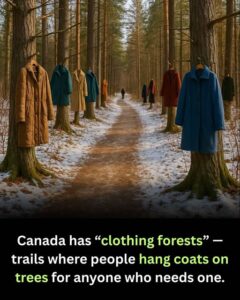When winter’s chill settles across Canada, bringing biting winds and heavy snowfall, warmth becomes more than just a comfort—it becomes a necessity for survival.
For many, especially those facing homelessness or financial hardships, access to warm clothing can be a daily struggle.
Yet, amid this harsh season, a quiet, heartfelt movement has blossomed: “clothing forests.”
These unique spaces turn ordinary public parks and wooded areas into open-air wardrobes, where coats, sweaters, scarves, hats, gloves, and even boots hang on branches, offering free warmth to anyone who needs it.

This grassroots initiative, spreading across cities and towns, is a powerful testament to community kindness and collective care.
What Are Clothing Forests? Clothing forests are simple yet profoundly impactful acts of generosity. Instead of the traditional donation drop-off points—bins, shelters, or charity centers—community members hang warm clothing on tree branches or loop items around trunks in accessible outdoor spaces. Often accompanied by notes that say, “If you need it, it’s yours,” these clothing forests operate on trust and dignity, giving people in need the freedom to take what they require without awkwardness, paperwork, or judgment. The idea embraces anonymity, respect, and the pure act of giving, transforming public spaces into safe havens of warmth.
Why Clothing Forests Matter:
The Canadian winter is notoriously unforgiving. For those without stable housing or limited resources, exposure to freezing temperatures can be dangerous, even life-threatening. Access to warm, dry clothing is essential but not always easy to secure. Clothing forests provide immediate, visible, and easy access to these essential items. The trees themselves, standing tall through winter storms and icy conditions, become symbols of endurance, hope, and protection. By decorating their branches with warm garments, communities send a clear message: nobody should have to face the cold alone.
Community Involvement and Sustainability:
Maintaining a clothing forest requires ongoing care and commitment. Local volunteers and organizations take active roles in managing these spaces—regularly checking to remove clothing that has become worn, dirty, or damp, and replenishing donations to ensure availability throughout the season. In some areas, specially designed waterproof bins or containers are placed nearby to hold smaller items like socks or gloves, protecting them from the elements. Schools, youth groups, faith organizations, and neighborhood associations often collaborate to host “clothing walks” or “tree decorating days,” events where people come together to hang new donations and spread awareness about the initiative. These gatherings not only replenish the clothing forests but also strengthen community bonds and promote the spirit of giving.
The Simple Power of Accessibility:
One of the most remarkable aspects of clothing forests is their straightforward accessibility. There are no applications to fill out, no waiting lines, and no questions asked. Anyone who is cold and in need can freely take what they require. This eliminates the barriers many face when trying to access aid—shame, pride, bureaucratic hurdles—and replaces them with trust and unconditional generosity. For donors, it offers a tangible, direct way to help others without intermediaries or complex logistics. This simplicity fosters an environment where kindness is visible, practical, and immediate.
Clothing Forests as Symbols of Hope and Community:
Beyond providing physical warmth, clothing forests symbolize a deeper sense of human connection and solidarity. They are a reminder that communities can come together to support their most vulnerable members in meaningful, compassionate ways. Each scarf or jacket hanging on a branch represents not just warmth but hope—hope that someone cares, that someone is watching out for them, and that even in the harshest seasons, kindness endures. These forests inspire people to think creatively about how we share resources and how public spaces can be used to foster inclusivity and mutual aid.
Broader Impact and Growing Awareness:
Since their emergence, clothing forests have gained attention not only within Canadian communities but also internationally, inspiring similar efforts in colder climates around the world. Social media has helped spread the message, encouraging more people to start their own clothing forests or support local initiatives. This movement highlights the importance of grassroots solutions in addressing social challenges, emphasizing how simple acts can have wide-reaching impacts when rooted in empathy and collective action.
Conclusion:
The next time you encounter a tree adorned with scarves, mittens, or coats in the depths of winter, remember that it stands as more than just a seasonal decoration. It is a living symbol of compassion—a testament to the power of small acts to make a big difference. In Canada’s freezing months, clothing forests do more than keep bodies warm; they warm hearts, foster hope, and knit communities closer together. They remind us all that even in the coldest times, humanity’s warmth shines brightest when we share it freely and generously.





